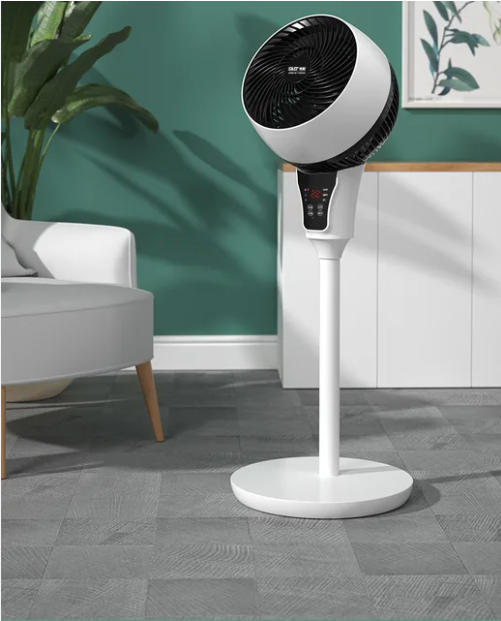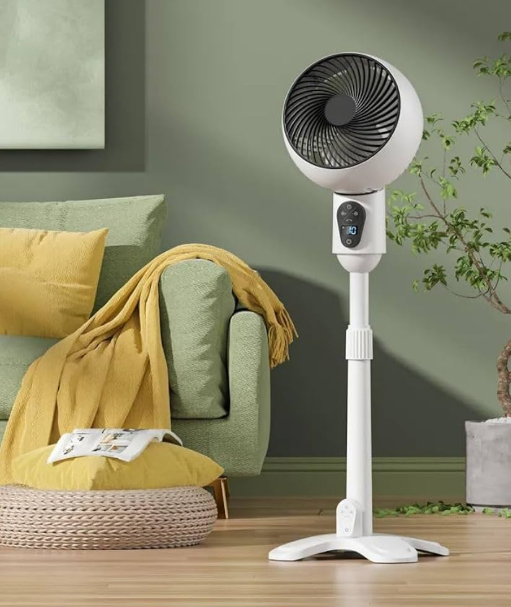Electric fans are a staple for staying cool, but like any appliance, they can develop issues over time. If you’re dealing with common electric fan problems, such as a fan that won’t turn on, makes strange noises, or fails to cool effectively, you’re not alone. This comprehensive guide will explore the most frequent issues with electric fans, provide practical electric fan troubleshooting steps, and offer solutions to keep your electric fan running smoothly. From electric fan maintenance to electric fan safety, we’ll cover everything you need to know to address these problems and enjoy reliable cooling.
Why Do Electric Fans Develop Problems?
Electric fans, including portable electric fans, are subject to wear and tear from regular use, dust buildup, or improper handling. Issues like poor maintenance, incorrect electric fan setup, or neglecting electric fan cleaning can lead to performance problems. By understanding the common electric fan problems, you can diagnose issues early and take steps to fix them before they worsen.
Top Common Electric Fan Problems and Solutions
Below are the most frequent issues electric fan users encounter, along with step-by-step solutions to address them. Always prioritize electric fan safety by unplugging the fan before performing any repairs or maintenance.
1. Fan Won’t Turn On
One of the most frustrating common electric fan problems is when the fan refuses to turn on. This could be due to electrical issues, a faulty switch, or a burned-out motor.
Possible Causes:
- Faulty power cord or plug.
- Broken switch or control knob.
- Blown fuse or tripped circuit breaker.
- Motor failure.
Troubleshooting and Fixes:
- Check the Power Source: Plug another device into the same outlet to ensure it’s working. If the outlet is faulty, try a different one.
- Inspect the Cord: Look for frayed or damaged wires. If the cord is damaged, replace it or consult a professional.
- Test the Switch: Use a multimeter to check the switch’s continuity. If it’s faulty, clean it with electrical contact cleaner or replace it (see how to fix an electric fan switch in our cooling guide).
- Check the Fuse: Some fans have an internal fuse. If it’s blown, replace it with one of the same rating.
- Examine the Motor: If the motor is burned out (indicated by a burning smell or no response), it may need repair or replacement. For older fans, replacing the unit might be more cost-effective.

2. Fan Makes Unusual Noises
A noisy fan—whether it’s rattling, buzzing, or grinding—is another common issue that can disrupt your comfort.
Possible Causes:
- Loose screws or parts.
- Dust or debris on blades or in the motor.
- Worn-out bearings or motor.
- Unbalanced blades.
Troubleshooting and Fixes:
- Tighten Loose Parts: Use a screwdriver to check and tighten screws on the grille, base, and blade assembly.
- Clean the Fan: Dust buildup can cause vibrations. Follow how to clean an electric fan steps: unplug the fan, remove the grille, and clean the blades and motor housing with a soft brush or cloth.
- Lubricate the Motor: If the motor bearings are serviceable, apply a small amount of lubricant to reduce friction and noise.
- Balance the Blades: Check for bent or misaligned blades. Use a blade balancing kit or replace damaged blades.
- Inspect the Motor: Persistent grinding noises may indicate a failing motor, which may require professional repair or replacement.
For more tips on reducing fan noise, check out our best electric fan guide.
3. Weak or Inconsistent Airflow
If your fan isn’t blowing air as strongly as it used to, it may not be cooling effectively, making it one of the common electric fan problems.
Possible Causes:
- Clogged grille or blades.
- Improper fan placement.
- Faulty capacitor or motor.
Troubleshooting and Fixes:
- Clean the Fan: Dust on the blades or grille can restrict airflow. Regular electric fan cleaning will restore performance.
- Optimize Electric Fan Setup: Place the fan on a flat surface, near a window, or in an open area to maximize airflow. Ensure no objects block the fan’s path.
- Check the Capacitor: Some fans have a capacitor that regulates speed. A faulty capacitor may cause weak airflow. Test it with a multimeter and replace it if necessary.
- Inspect the Motor: A weak motor may struggle to spin the blades effectively. If cleaning and setup adjustments don’t help, the motor may need repair.
4. Fan Overheats
An overheating fan can feel hot to the touch or shut off unexpectedly, posing a safety risk and reducing performance.
Possible Causes:
- Dust buildup in the motor or blades.
- Overworked motor from continuous high-speed use.
- Poor ventilation around the fan.
Troubleshooting and Fixes:
- Clean the Fan: Remove dust from the motor and blades to prevent overheating. Follow proper electric fan cleaning techniques.
- Reduce Usage Time: Avoid running the fan at maximum speed for extended periods. Use lower speeds or a timer to give the motor a break.
- Improve Ventilation: Ensure the fan has enough space around it for proper airflow to prevent heat buildup.
- Check the Motor: If overheating persists, the motor may be failing and require professional attention.
5. Fan Wobbles or Vibrates Excessively
A wobbling or vibrating fan can be noisy and unstable, increasing the risk of tipping over.
Possible Causes:
- Unbalanced blades.
- Loose screws or components.
- Uneven surface.
Troubleshooting and Fixes:
- Check Blade Balance: Inspect the blades for bends or debris. Use a blade balancing kit or replace damaged blades.
- Tighten Components: Secure all screws and parts on the fan’s base, grille, and blade assembly.
- Place on a Flat Surface: Ensure the fan is on a level, stable surface to minimize vibrations.
6. Switch or Speed Settings Don’t Work
If the fan’s switch or speed settings are unresponsive, you may not be able to turn it on or adjust its speed.
Possible Causes:
- Faulty switch.
- Loose or disconnected wiring.
- Dirty switch mechanism.
Troubleshooting and Fixes:
- Clean the Switch: Dust or debris can cause the switch to stick. Use compressed air or electrical contact cleaner to clean it.
- Check Wiring: Open the fan’s housing (after unplugging) and inspect the switch’s wiring for loose or disconnected wires. Secure them with electrical tape if needed.
- Test with a Multimeter: Use a multimeter to check the switch’s continuity. If it’s faulty, replace it with a compatible switch.
For a detailed guide on repairing a switch, visit electricfanatic.com.

Electric Fan Maintenance to Prevent Common Problems
Preventing common electric fan problems starts with regular electric fan maintenance. Here are essential tips to keep your fan in top condition:
- Regular Cleaning: Clean your fan every 3–6 months to remove dust from the blades, grille, and motor. This improves airflow and prevents overheating.
- Lubricate the Motor: If the motor is serviceable, apply a small amount of lubricant to the bearings to reduce friction and noise.
- Tighten Loose Parts: Periodically check and tighten screws and components to prevent wobbling or noise.
- Store Properly: When not in use, store the fan in a dry, dust-free environment to protect its components.
- Avoid Overuse: Don’t run the fan at maximum speed for extended periods to reduce strain on the motor and switch.
By incorporating these electric fan maintenance habits, you can minimize the risk of issues and extend your fan’s lifespan.
Electric Fan Safety Tips for Repairs
When addressing common electric fan problems, always follow electric fan safety guidelines to avoid injury or damage:
- Unplug the Fan: Always disconnect the fan from the power source before troubleshooting or repairing.
- Use Insulated Tools: Use screwdrivers with insulated handles to reduce the risk of electric shock.
- Work in a Dry Area: Avoid repairing the fan in damp or wet environments.
- Know Your Limits: If you’re unsure about electrical repairs, consult a professional to avoid damaging the fan or risking injury.
When to Replace Your Electric Fan
In some cases, fixing common electric fan problems may not be worth the effort, especially for older or heavily damaged fans. Consider replacing your fan if:
- The motor is burned out or damaged beyond repair.
- Multiple components (e.g., switch, blades, and motor) are faulty.
- The cost of repairs exceeds the price of a new, more efficient fan.
If you’re ready to upgrade, check out this best electric fan guide for recommendations on reliable, high-performance models.
Conclusion: Keep Your Electric Fan Running Smoothly
Dealing with common electric fan problems doesn’t have to be overwhelming. By understanding issues like a fan that won’t turn on, makes noise, or has weak airflow, you can use electric fan troubleshooting to diagnose and fix them. Regular electric fan cleaning, proper electric fan setup, and consistent electric fan maintenance are key to preventing problems and ensuring your portable electric fan or larger model performs reliably. With these electric fan tips, you can enjoy cool, comfortable air without interruptions.
For more advice on fixing, maintaining, or choosing a new fan, visit electricfanatic.com. With the right care, your electric fan will keep you cool and comfortable for years to come!